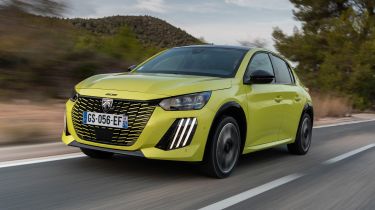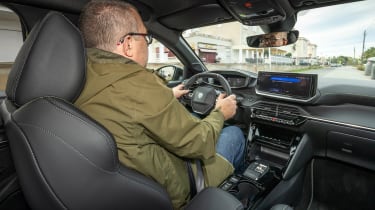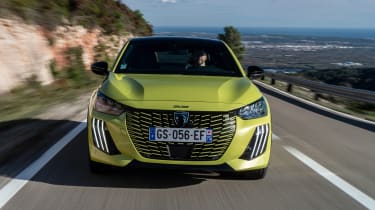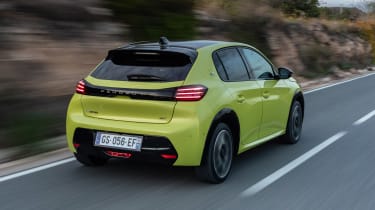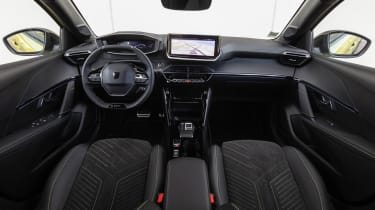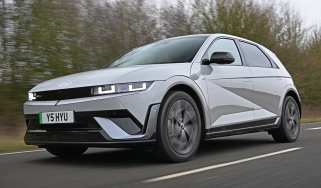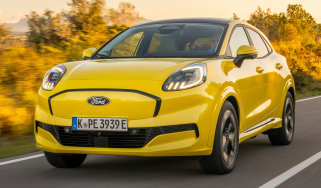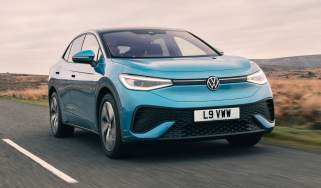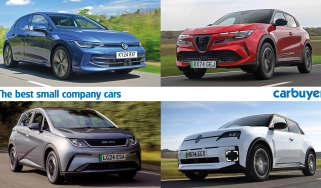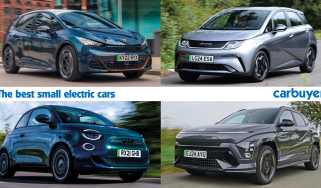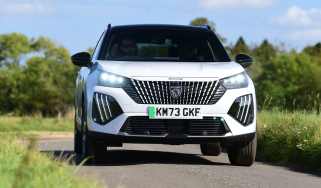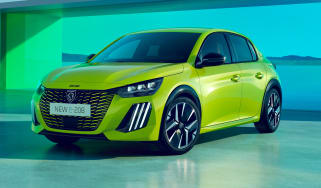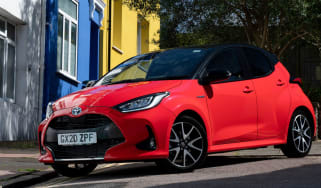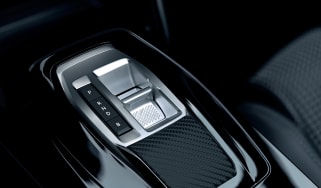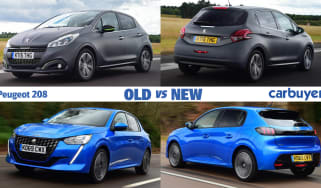Peugeot E-208 review - stylish EV, but tight on space
"The Peugeot E-208 is a stylish small EV with a competitive range, but it’s a bit cramped"
Pros
- Low running costs
- Stylish design
- Punchy performance
Cons
- Cramped rear seats
- No cable storage
- Can get pricey
Verdict - is the Peugeot E-208 a good car?
The Peugeot E-208 is the facelifted version of the French manufacturer’s electric supermini, with a bold new face. If you pick the updated electric motor and battery, it can also go further and faster than before, making it even more usable if you need to drive long distances.
The E-208 is a stylish little number, but this doesn’t come without any negatives – there’s less space in the back than an MG4 or BYD Dolphin offers. Still, if you don’t mind this and the premium price tag, the E-208 is a contender in the small electric car class.
Peugeot E-208 models, specs and alternatives
While some manufacturers, such as Nissan and Renault, believe electric cars should look a little different, Peugeot thinks choosing between petrol, diesel or electric should be as normal as choosing a trim level. That's why the fully electric Peugeot e-208 was launched at the same time as the petrol and diesel models, came in most of the same trim levels and looked nearly identical.
For the 2022 model year, Peugeot made the electric powertrain more efficient, resulting in a rise in range from 217 to 225 miles. Just one year later, Peugeot’s supermini benefitted from a mid-life facelift, ushering in a new battery pack and electric motor boosting its range further to 248 miles, along with a name change from ‘e-208’ to ‘E-208’.
 Top 10 best small electric cars 2025
Top 10 best small electric cars 2025
The Peugeot 208 is a firm family favourite and a fully electric version of it is yet another indication that electric motoring is becoming increasingly mainstream. The only ways you'll be able to spot the difference are a blue lion badge, some body-coloured flashes on the grille and the E-208 badge – until you pull away in near-silence, of course. The updates brought in for the car’s refresh are most obvious at the front, where ‘three-claw’ vertical LED lights give it a distinctive look similar to the bigger Peugeot 308 and 408. There are new horizontal tail-lights too, along with new wheels and paint colours – like the lurid ‘Agueda Yellow’ of the car we’ve just sampled.
More reviews
This theme continues inside the E-208, where the low-slung driving position faces digital '3D' instruments and a small steering wheel that looks like it's been borrowed from a racing car. There's a youthful appeal, backed up by soft, sophisticated materials inspired by successful models like the Peugeot 3008. There’s a new 10-inch infotainment screen for 2023, along with a digital instrument panel for Allure and GT trims.
Under the bonnet, there’s now a choice of two power levels for the next few months. The first is the original 134bhp electric motor, and even this gives the E-208 a real turn of speed, so anyone looking to save money shouldn’t feel too shortchanged – especially for urban driving. In Sport mode, it's noticeably more potent than the ZOE, which may have been tuned with more economical driving in mind. Then there’s the new 154bhp motor, which has the potential to be even quicker, but only gives you its full output in Sport mode, so doesn’t feel that different in everyday driving.
This comes with a new 51kWh battery for a range of nearly 250 miles, beating the MINI Electric or Honda e. The E-208 also boasts faster 100kW charging than the ZOE, making it possible to add 100 miles of range in 20 minutes.
While there wasn’t previously much choice in the small EV class, that’s set to change drastically in the coming years. There’s a wave of more affordable models arriving and on the way, led by the BYD Dolphin that’s due to be joined by the likes of the Volkswagen ID.2, Citroen e-C3 and a reimagining of the Renault Twingo with prices rumoured to be just over £20,000. While the Peugeot E-208 is undeniably appealing, it could start to look even more steeply priced if this wave of budget EVs materialises at their suggested price points.
Range, charging & running costs
The Peugeot E-208 is now available with two battery sizes, a 50kWh unit that can deliver a driving range of up to 225 miles and a new, slightly larger and newer unit that boosts range to 248 miles between charges. It should make longer drives more convenient with fewer charging stops, but if you’d rather go for the E-Style trim it’s still got plenty of range for urban driving and comes with plenty of standard kit.
The Peugeot beats the Renault ZOE when it comes to charging, thanks to its 100kW rapid-charging capability, which is double that of the Renault. Find a charger running at 100kW and it'll add 100 miles of range in just 20 minutes – the larger 2023 battery can be topped up from 20-80% in as little as 25 minutes. More common 50kW charging posts will do the same in 40 minutes, while a 7kW home wallbox can fully charge the e-208 in under eight hours. The CCS and Type 2 charging ports are hidden behind a flap on the rear wing. It's worth noting a standard three-pin cable costs extra, but charging from a standard socket will likely take too long for many owners.
Road tax for EVs is free until the rules change in 2025, and Benefit-in-Kind taxation for company-car drivers has also been reduced to just 2%, resulting in big potential savings versus cars with higher CO2 emissions.
Electric motor, drive & performance
While previously the Peugeot was available with just one 134bhp electric motor, it’s currently offered with the choice of this or the new 154bhp motor shared with the Peugeot E-308. No matter which you choose, the E-208 is the most powerful version in the 208 range, and it feels very quick off the mark. It's faster and more lively than the top-spec R135 ZOE, especially in its Sport driving mode.
In day-to-day driving, this means there’s a healthy dose of acceleration when you need to pull out briskly or pass slower traffic in town. It feels plenty quick enough for most drivers in Normal mode, and if you press the throttle hard enough, the full 154bhp is activated briefly. Eco mode is rather sluggish, though, reducing power to 80bhp to save battery.
We still find Peugeot's small steering wheel polarising, but there's no denying it makes the E-208 feel alert in town and on country lanes. In equal measure, it can be less intuitive when manoeuvring. There’s some body lean in corners, but the E-208 feels very surefooted, even if its steering doesn’t offer the sort of feel and feedback that makes it really enjoyable. If fun is what you’re after, the MINI Electric feels a lot more responsive and grippy.
Back off the E-208's accelerator at speed and there's a mild braking force as the electric motor harnesses kinetic energy to top up the batteries. It's been programmed to feel as natural as possible to avoid putting off EV newcomers, but nudge the gearlever into 'B' mode and the regenerative braking force increases noticeably, so you won't have to use the brake pedal very often in routine driving.
Interior & comfort
Drop behind the steering wheel, and there’s a real sense that the design and style of the E-208’s interior were just as important as its practicality in the car’s development. It feels quite low and sporty, with a dashboard that’s angular and covered in a real mix of materials. These mostly look upmarket and attractive, but some like the piano black plastic and carbon-effect trim seem a bit cheap when you touch them. It’s still ahead of rivals like the BYD Dolphin and Vauxhall Corsa Electric, but the MINI Electric feels posher.
A 10-inch standard-definition infotainment display is included on all mainstream models, with Apple CarPlay and Android Auto compatibility thrown in for good measure. A 10-inch HD version of the central screen comes with the Allure model upwards, bringing improved graphics and the addition of a 10-inch instrument display. We just hope you get to see it, because some drivers find their natural seating position causes the top of the steering wheel to block the dials, leading them to sit higher up than normal, or drop the wheel closer to their legs to compensate. The infotainment software can be confusing, but there's no arguing with the level of kit on offer, especially from Allure trim, which includes all-around parking sensors and even a special acoustic windscreen to improve refinement.
That said, even the basic Active trim gets a leather steering wheel, LED exterior lighting, air-conditioning and pre-heating, so you can warm up the cabin on a frosty day before heading out. E-Style is best thought of as an interim trim level, using the lower-powered electric motor and smaller battery, along with the older seven-inch infotainment setup, but with the looks of the new car.
In contrast, the E-208 GT range-topper gets all the bells and whistles, including items like sports seats, 17-inch alloy wheels, a contrasting black roof and green stitching dotted around its interior. Even a potent 15-watt wireless smartphone charger is included, along with tech to automatically adjust the headlights and unlock the doors without you needing to reach for its key fob.
Practicality & boot space
The Peugeot 208 range has been built on a platform engineered to accommodate petrol, diesel and fully electric powertrains. It's shared with the Vauxhall Corsa Electric and means that adding a sizeable battery pack to the car doesn't cut into passenger or luggage space. Instead, the batteries are distributed under the car floor and the rear seats, but, like the petrol 208, the Peugeot trades some interior space for its small and stylish dimensions. The boxier Skoda Fabia has more space for tall passengers in the back, and anyone over six feet tall will struggle with rear legroom and headroom in the E-208. If you need to carry passengers regularly, the bigger MG4 will be a safer bet, thanks to its larger rear cabin and bigger openings for the back doors.
While it might feel tight inside, there are quite a few places to put things, including generous door bins, cubbies and a spot ahead of the gearlever to throw your phone or wallet. A hidden compartment also doubles as a wireless charger on top trims.
Boot space measures 309 litres, rising to 1,118 litres with the rear seats folded down, which is about average for the supermini class. The ZOE can hold slightly more at 338 litres, partly thanks to its taller stance, while the BYD Dolphin and MG4 are slightly better again, thanks to their larger, more boxy shapes. There's also one big oversight, and that's a lack of a space dedicated to storing its charging cables, meaning your items will be lumped in with a potentially wet and dirty set of leads. There’s also a tall lip to lift your shopping or suitcases over to get them into the boot in the first place.
Reliability & safety
Peugeot has produced a string of five-star Euro NCAP cars, but the 208 and E-208 achieved a four-star score, despite coming with more safety kit than ever before. This is partly because safety testing has become much tougher – the Renault ZOE scored zero stars when it was re-tested by Euro NCAP in 2021. The Peugeot still offers plenty of driving aids though, with features that help keep the car in its lane on the motorway, brake automatically in an emergency and monitor the driver for signs of drowsiness.
Reliability will take longer to judge because while there's theoretically much less to go wrong with an electric powertrain (and far less to maintain) this is Peugeot's first mainstream EV. Any issues are likely to be with teething problems and electrical gremlins. Early signs are mostly positive, though, because overall the 208 finished in 37th place in our top 75 cars list for 2022, before dropping slightly to 51st place in 2023. This also included the petrol car, and the 208 scored excellent results in the engine and gearbox, ride and handling and exterior design categories. It was also given an average rating for reliability and build quality.
Peugeot as a brand performed well overall in our latest Driver Power survey, coming ninth out of the 32 manufacturers included, with a reasonable 19% of owners reporting a fault within the first year. It’s also worth noting that Peugeot’s battery packs are covered by an eight-year warranty for added peace of mind.
Which Is Best?
Cheapest
- Name100kW Allure 50kWh 5dr Auto
- Gearbox typeAuto
- RRP£29,050
Most Economical
- Name115kW Allure 51kWh 5dr Auto
- Gearbox typeAuto
- RRP£29,850
Fastest
- Name100kW Allure 50kWh 5dr Auto
- Gearbox typeAuto
- RRP£29,050
